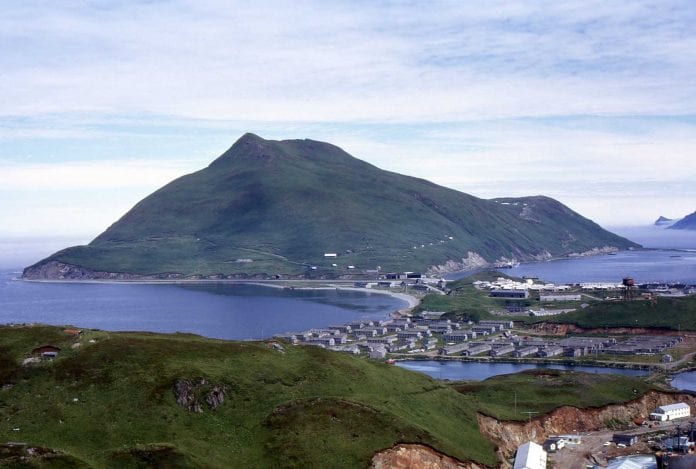
Seafood Super Power
Alaska is the nation’s super power with five Alaska ports ranking in the top 10 for seafood landings and values.
“Dutch Harbor keeps its long-time title, 20 years strong now, as our nation’s top fishing port for the amount of seafood landed (770 million pounds), and New Bedford, Massachusetts is hanging strong claiming for the 17th consecutive year the highest valued catch ($327 million) mostly due to the highly valued sea scallop fishery,” said Ned Cyr, director of NOAA Fisheries Office of Science and Technology, referring to the annual Fisheries of the U.S. report for 2016.
Other Alaska ports making the top 10 list are the Aleutian Islands at second, thanks to the Trident plant at Akutan, the largest seafood processing facility in the U.S.
Kodiak dropped a spot to fourth place, followed by the Alaska Peninsula in seventh place and Naknek in ninth place. Other Alaska ports making the top 50 ports for seafood landings and/or values are Ketchikan, Sitka, Bristol Bay, Petersburg, Seward, Cordova, Kenai and Juneau.
Alaska led all states in seafood volumes at 5.6 billion pounds and values at $1.6 billion.
Alaska Pollock accounted for 30 percent of U.S. fish poundage, and 21 percent of the value. Nearly 97 percent of all U.S. salmon landings were from Alaska.
The U.S. continues to import most of its seafood – 5.8 billion pounds in 2016, up slightly. Whatever its source, Americans are eating less of it.
U.S. seafood consumption fell last year to 14.9 pounds per person, down from 15.5 pounds in 2015.
Seafood favorites
Shrimp held onto the number one spot for America’s seafood favorites, followed by salmon. The Top 10 list is compiled each year by the National Fisheries Institute based on per capita consumption in the U.S. Fisheries report data.
Canned tuna, farmed tilapia and Alaska Pollock rounded out the top five, followed by farmed pangasius, cod, crab, catfish and clams.
Almost all of the drop was attributable to salmon, pointed out John Sackton of Seafood.com.
“Alaska landed 300 million pounds less salmon, mostly due to a shortfall in pinks. When converted to edible weight, this accounts for almost all the drop in salmon consumption,” he said.
The biggest winner is cod, Sackton said, as it has taken an increased share of the whitefish market over the past five years, going from 0.52 pounds per capita to 0.66 pounds.
Pacific Marine Expo
Pacific Marine Expo will top the half-century mark when the trade show’s doors open later this month in Seattle.
“Fifty-one years and still growing,” said said Denielle Christensen, Expo director for Diversified Communications, which produces marine events and publications around the world. “We are looking at having 550 exhibitors this year, which is an increase of 30 more companies.”
The Pacific Expo is her favorite, she said, because it has a “strong community feel.”
“A lot of folks only see each other once a year at this event. It’s just the happiest group of people,” Christensen added.
The trade show has broadened over the years to include all mariner needs and interests, but organizers have “never forgotten that commercial fishing is where we came from and that is the group that helped the show become what it is today,” Christensen said.
New this year is an expanded Alaska Hall that will house nearly 50 companies, Expo’s main stage, the Fishermen of the Year competition and daily happy hours.
Also debuting – the Alaska Symphony of Seafood will hold its annual new products competition and tasting, along with a hall of fame displaying 25 years of past Symphony winners.
Pacific Marine Expo runs Nov. 16-18 at the Century Link Center in Seattle. All events are free with pre-registration.
“Before the show opens on Thursday if you use the code FISH you will be guaranteed free registration,” Christensen said, “and that includes educational programs, the key note and everything happening on the floor.”
IFISH Calls
The call is out for participants in the IFISH 5 conference, the largest international gathering of fishing, aquaculture and seafood processing industry safety and health professionals.
“We are looking for session proposals for round table talks or panel discussions, as well as abstracts,” said Jennifer Lincoln, director of the Maritime Safety and Health Studies Center at the National Institute of Occupational Safety and Health.
Lincoln said it is the first time in a decade the conference has reconvened. Deadline to apply is Nov. 15. IFISH 5 is set for June 10-13, 2018 in Newfoundland and Labrador, Canada. Questions? Contact ifish@mun.ca.














